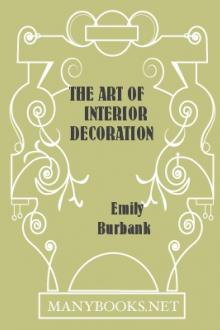The Art of Interior Decoration by Emily Burbank (good summer reads TXT) 📕

- Author: Emily Burbank
- Performer: -
Book online «The Art of Interior Decoration by Emily Burbank (good summer reads TXT) 📕». Author Emily Burbank
"Cut-work" is embroidery that is cut out and appliqued, or sewed on another material.
Carpets which were used in Western Europe in the Middle Ages are seldom seen. The Kensington Museum owns two specimens, both of them Spanish, one of the fourteenth and one of the fifteenth century.
In speaking of Gothic art we called attention to the fostering of art by the Church during the Dark Ages. This continued, and we find that in Henry VIII's time those who visited monasteries and afterward wrote accounts of them call attention to the fact that each monk was occupied either with painting, carving, modelling, embroidering or writing. They worked primarily for the Church, decorating it for the glory of God, but the homes of the rich and powerful laity, even so early as the reign of Henry III (1216-1272), boasted some very beautiful interior decorations, tapestries, painted ceilings and stained glass, as well as carved panelling.
Bostwick Castle, Scotland, had its vaulted ceiling painted with towers, battlements and pinnacles, a style of mural decoration which one sees in the oldest castles of Germany. It recalls the illumination in old manuscripts.
CHAPTER V CANDLESTICKS, LAMPS, FIXTURES FOR GAS AND ELECTRICITY, AND SHADESCandlesticks, lamps, and fixtures for gas and electricity must accord with the lines of your architecture and furniture. The mantelpiece is the connecting link between the architecture and the furnishing of a room. It is the architect's contribution to the furnishing, and for this reason the keynote for the decorator.
In the same way lighting fixtures are links between the construction and decoration of a room, and can contribute to, or seriously divert from, the decorator's design.
It is important that fixtures be so placed as to appear a part of the decoration and not merely to illuminate conveniently a corner of the room, a writing-desk, table or piano.
The dining-room of this apartment is Italian Renaissance—oak, almost black from age, and carved.
The seat pads and lambrequin over window are of deep red velvet. The walls are stretched with dull red brocotello (a combination of silk and linen), very old and valuable. The chandelier is Italian carved wood, gilded.
Attention is called to the treatment of the windows. No curtains are used, instead, boxes are planted with ivy which is trained to climb the green lattice and helps to temper the light, while the window shades themselves are of a fascinating glazed linen, having a soft yellow background and design of fruit and vines in brilliant colours.
In planning your house after arranging for proper wall space for your various articles of furniture, keep in mind always that lights will be needed and must be at the same time conveniently placed and distinctly decorative.
One is astonished to see how often the actual balance of a room is upset by the careless placing of electric fixtures. Therefore keep in mind when deciding upon the lighting of a room the following points: first, fixtures must follow in line style of architecture and furniture; second, the position of fixtures on walls must carry out the architect's scheme of proportion, line and balance; third, the material used in fixtures—brass, gilded wood, glass or wrought iron—must contribute to the decorator's scheme of line and colour; fourth, as a contribution to colour scheme the fixtures must be in harmony with the colour of the side walls, so as not to cut them up, and the shade should be a light note of colour, not one of the dark notes when illuminated.
This brings us to the question of shades. The selecting of shapes and colours for shading the lights in your rooms is of the greatest importance, for the shades are one of the harmonics for striking important colour notes, and their value must be equal by day and by night; that is, equally great, even if different. Some shades, beautiful and decorative by daylight, when illuminated, lose their colour and become meaningless blots in a room. We have in mind a large silk lamp shade of faded sage green, mauve, faun and a dull blue, the same combination appearing in the fringe—a combination not only beautiful, but harmonising perfectly with the old Gothic tapestry on the nearby wall. Nothing could be more decorative in this particular room during the day than the shade described; but were it not for the shell-pink lining, gleaming through the silk of the shade when lighted, it would have no decorative value at all at night.
In ordering or making shades, be sure that you select colours and materials which produce a diffused light. A soft thin pink silk as a lining for a silk or cretonne shade is always successful, and if a delicate pink, never clashes with the colours on the outside. A white silk lining is cold and unbecoming. A dark shade unlined, or a light coloured shade unlined, even if pink, unless the silk is shirred very full, will not give a diffused, yellow light.
It is because Italian parchment-paper produces the desired glow of light that it has become so popular for making shades, and, coming as it does in deep soft cream, it gives a lovely background for decorations which in line and colour can carry out the style of your room.
Figured Italian papers are equally popular for shades, but their characteristic is to decorate the room by daylight only, and to impart no quality to the light which they shade. Unless in pale colours, they stop the light, absolutely, throwing it down, if on a lamp, and back against the wall, if on side brackets. Therefore decorators now cut out the lovely designs on these figured papers and use them as appliques on a deep cream parchment background.
When you decide upon the shape of your shades do not forget that successful results depend upon absolutely correct proportions. Almost any shape, if well proportioned as to height and width, can be made beautiful, and the variety and effect desired, may be secured by varying the colours, the design of decoration, if any, or the texture or the length of fringe.
The "umbrella" shades with long chiffon curtains reaching to the table, not unlike a woman's hat with loose-hanging veil, make a charming and practical lamp shade for a boudoir or a woman's summer sitting-room, especially if furnished in lacquer or wicker. It is a light to rest or talk by, not for reading nor writing.
The greatest care is required in selecting shades for side-wall lights, because they quickly catch the eye upon entering a room and materially contribute to its appearance or detract from it.
CHAPTER VI WINDOW SHADES AND AWNINGSThe first thing to consider in selecting window shades when furnishing a house, is whether their colour harmonises with the exterior. Keeping this point in mind, further limit your selection to those colours and tones which harmonise with your colour schemes for the interior. If you use white net or scrim, your shades must be white, and if ecru net, your shades must be ecru. If the outside of your house calls for one colour in shades and the interior calls for another, use two sets. Your dark-green sun shades never interfere, as they can always be covered by the inner set. Sometimes the dark green harmonises with the colouring of the rooms.
A room often needs, for sake of balance, to be weighted by colour on the window sides more than your heavy curtains (silk or cretonne) contribute when drawn back; in such a case decorators use coloured gauze for sash curtains in one, two or three shades and layers, which are so filmy and delicate both in texture and colouring that they allow air and light to pass through them, the effect being charming.
Another way to obtain the required colour value at your windows is the revival of glazed linens, with beautiful coloured designs, made up into shades. These are very attractive in a sunny room where the strong light brings out the design of flowers, fruits or foliage. Plate X shows a room in which this style of shade is used with great success. It is to be especially commended in such a case as Plate X, where no curtains are used at windows. Here the figured linen shade is a deliberate contribution to the decorative scheme of the room and completes it as no other material could.
Awnings can make or mar a house, give it style or keep it in the class of the commonplace. So choose carefully with reference to the colour of your house. The fact that awnings show up at a great distance and never "in the hand," as it were, argues in favour of clear stripes, in two colours and of even size, with as few extra threads of other colours as possible.
Shows a part of a fine, old Italian refectory table, and one of the chairs, also antiques, which are beautifully proportioned and made comfortable with cushions of dark red velvet, in colour like curtains at window, which are of silk brocade.
The standard electric lamps throw the light up only. There are four, one in each corner of the room, and candles light the table.
The wall decoration here is a flower picture.
All awnings fade, even in one season; green is, perhaps, the least durable in the sun, yellows and browns look well the longest. Fortunately an awning, a discouraging sight when taken down and in a collapsed mass of faded canvas, will often look well when up and stretched, because the strong light brings out the fresh colour of the inside. Hence one finds these rather expensive necessities of summer homes may be used for several seasons.
CHAPTER VII TREATMENT OF PICTURES AND PICTURE FRAMESStrive to have the subject of your pictures appropriate to the room in which they are to be hung.
It is impossible to state a rule for this, however, because while there are many styles of pictures which all are able to classify, such as old paintings which are antique in colouring, method and subject, portraits, figure pictures, architectural pictures, flower and fruit pictures, modern oil paintings of various subjects (modern in subject, method and colouring), water colours, etchings, sporting prints, fashion prints, etc., there is, also, a subtle relationship between them seen and felt only by the connoisseur, which leads him to hang in the same room, portraits, architectural pictures and flower pictures, with beautiful and successful results. Often the relationship hangs on similarity in period, style of painting or colour scheme. Your expert will see decorative value in a painting which has no individual beauty nor intrinsic worth when taken out of a particular setting.
The selecting of pictures for a room hinges first on their decorative value. That is, their colour and size, and whether the subjects are appropriate and sympathetic.
Always avoid heavy gold frames on paintings, for, unless they are real objects of art, one gets far more distinction by using a narrow black moulding. When in doubt always err on the side of simplicity.
If your object is economy as well as simplicity, and you are by chance just beginning to furnish your house and own no pictures, we would suggest good photographs of your favourite old masters, framed close, without a margin, in the passepartout method (glass with a narrow black paper tape binding).
Old coloured prints need narrow black passepartout, while broad passepartout in pink, blue or pale green to match the leading tone in wall paper makes your quaint, old black-and-white prints very decorative.
Never use white margins on any pictures unless your walls are white.
The decorative value of





Comments (0)